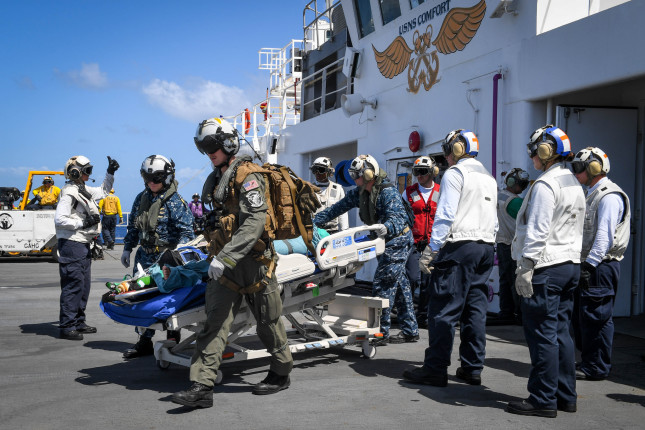-
Hurricane Maria’s Death Toll: Public Health Researchers Voice Frustration

Once again, we find ourselves witnessing another calamitous hurricane event in the United States, just weeks after a George Washington University report estimated that nearly 3,000 more people died in the 6 months following last year’s Hurricane Maria than would have without the hurricane. We have been here before, too many times. With each and every major disaster, the scientists who study public health in crises ask ourselves, is what we have learned and shared being taken seriously—or is it just being ignored? The response to Hurricane Maria, which devastated Puerto Rico last year, is just one more example where we have to ask if our work is valued by those who have the political power to improve public health. The staggering number of excess deaths—most of whom died after the storm—point to a deadly lack of prevention and preparedness, particularly in the public health system.
Excess Mortality is Predictably Predictable
Each and every natural disaster reveals the underlying strengths of the public health system and exposes its vulnerabilities. Maria created a major public health emergency: Puerto Rico lost water, sanitation, food, shelter, and energy, as well as access to healthcare services, including vaccines, maternal and child health, and mental health programs, among many others.
When the disaster occurred, a highly respected disaster logistician was immediately detailed to work with Puerto Rico’s Ministry of Health. Early on, he called us to ask: “What do I need to know to make a difference?” Our advice was, “you already know how many died; what is crucial is preventing any new deaths and suffering.”
Months later, the New York Times reported that while the official direct death toll was 62, the indirect or preventable mortality 42 days after the storm was 1,052. And just last month, Puerto Rico Governor Ricardo Rossello acknowledged the George Washington University study that raised the death rate to a shocking 2,975 people—and the death rate was highest for those Puerto Ricans that lived in the poorest municipalities.
Chances are that these numbers will continue to climb, as parts of the island’s public health infrastructure is still compromised. We expect the 2018 hurricane season could once again expose the system’s vulnerabilities through greater mortality and morbidity. Some things are “predictably predictable.”
Saving Us From Ourselves
Where did we fail the people of Puerto Rico? Does each and every generation of disaster responders have to relearn these lessons—as though this phenomenon is suddenly new? Has our years of research not been heeded, or have we abdicated our knowledge base and decision-making to governments and politicians alone?
One crucial lesson we learned from the Ebola scare in 2012 was that better scientific information does not lead to better outcomes among political decision-makers. As Dan Hanfling and I wrote in Current Disasters, “politicians listen to economists not to scientists.” One reason for this is that research on its own is not sufficient. As Ryan Meyer wrote for nature.com, “solving societal problems is a lot more complicated and difficult than generating new knowledge.”
In a forthcoming paper on the current state of disaster science for our nation’s health, one of us (Keim) found that “capability maturity” in the United States is operating at an estimated Level II, or about 40 percent of its optimum potential. We know that collective advocacy through evidenced-based research, both quantitative and qualitative, can improve the capacity to influence the political environment and the relationship between lawmakers and policymakers—but only when we create a stronger evidence base from existing data that is taken seriously.
Disaster research must become more multidisciplinary and transdisciplinary. Publishing and conferencing with those in the social sciences, politics, and the law—to name but a few fields—is a necessary first step in informing both the public and decision-makers. We publish our findings in journals read primarily by fellow scientists, but too often, these articles are unnoticed by decision-makers. Increasingly, leaders in disaster medicine are recognizing that the political work to improve people’s lives must be done through proxies that can translate research in a way that the public and politicians can understand it. But why? Do we lack the incentives, political will, and the status to do it ourselves?
Most critically, what are the consequences for the people we swore to protect if governments fail to operate on evidence-based approaches or scientific facts? Will responses to public health emergencies continue to be reactive, insufficient, and not sustained, resulting in harmful program and funding cuts? We must resist political efforts to only focus on the response to crises, and ignore the prevention and preparedness phases—otherwise, we will not have the resources to save us from ourselves.
Dr. Frederick M. Burkle, Jr., is a retired professor and Senior Fellow & Scientist at the Harvard Humanitarian Initiative, Harvard University and Harvard T.H. Chan School of Public Health, and a Senior Scholar at the Woodrow Wilson Center.
Dr. Mark Keim is Director & Chief Executive Officer of DisasterDoc; Senior Science Advisor for the National Center for Disaster Medicine and Public Health; and an adjunct professor at the Rollins School of Public Health.
Sources: CNN, Disaster Medicine and Public Health Preparedness, George Washington University, Nature, PLOS Current Disasters
Photo Credit: Sailors embarked aboard the Military Sealift Command hospital ship USNS Comfort escort a patient to an MH-60S Sea Hawk helicopter assigned to the “Sea Knights” of Helicopter Sea Combat Squadron (HSC) 22. HSC-22 transferred the patient to Centro Medico hospital in San Juan, Puerto Rico, after receiving care aboard the ship. October 2017. U.S. Navy photo by Mass Communication Specialist 1st Class Ernest R. Scott.
 A Publication of the Stimson Center.
A Publication of the Stimson Center.



